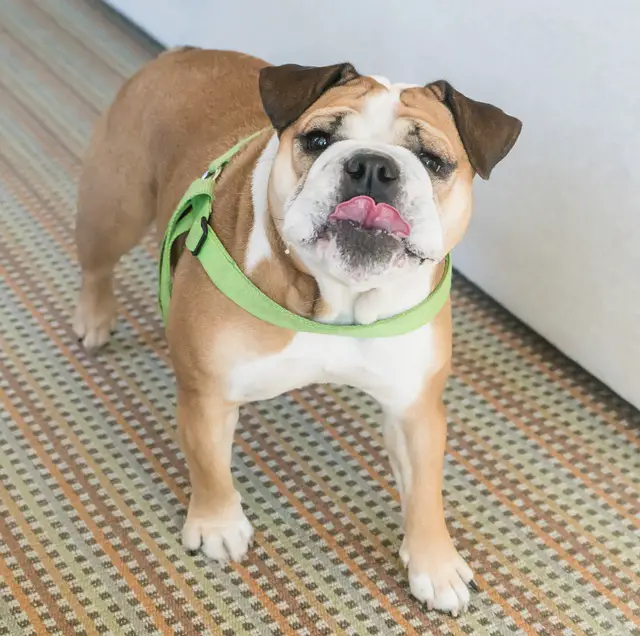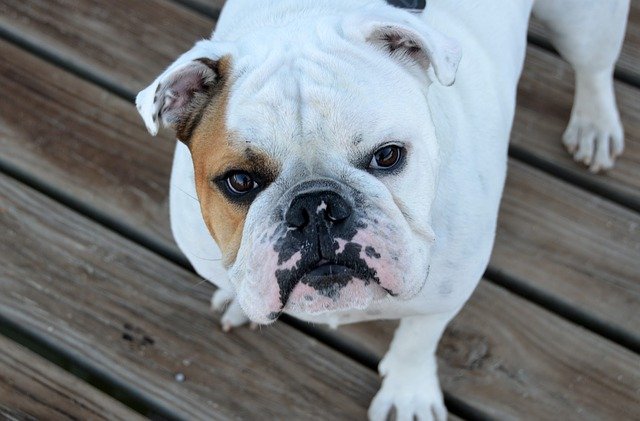Your dog finally mastered the skills of potty training. The process was challenging, but now you can rest assured there will be no surprise puddles around the house. And suddenly, wet spots start appearing wherever your dog sits.
My dog leaves odorless wet spots; why? When a dog leaves odorless wet spots, it is probably experiencing urinary incontinence – the inability to refrain from peeing. In most cases, your dog is not even aware that it is leaking urine.
Incontinence is not a behavior-related urination issue. Urinary incontinence is a medical condition that requires prompt veterinary attention. So, instead of scolding your dog, call your vet and schedule an appointment.
WHY IS MY DOG LEAVING WET SPOTS?

Peeing accidents are not always due to a lack of potty training. Sometimes they are the consequence of a medical issue. These are some of the most common medical issues that may lead to urinary incontinence in dogs.
Anatomic abnormalities
Many anatomic abnormalities can result in urinary incontinence. Some anomalies are congenital, while others are due to injuries.
For example, ectopic ureters and urethral hypoplasia are birth defects that manifest with urinary issues, including leaving wet spots or puddles.
In terms of injuries, traumatic events and certain surgeries can alter blood function and lead to urine leaking.
Neurological causes
Spinal injuries that result in damaging the nerves responsible for controlling the bladder result in urinary incontinence.
The same issue can be triggered by brain tumors and lesions in parts of the brain responsible for bladder control.
Bladder storage dysfunction
Bladder storage dysfunction is a specific condition that manifests with bladder hypercontractility.
As a result, the bladder contracts more frequently and evens stronger than normal, which results in urine leakage and leaving wet spots.
Urinary tract infections (UTIs)
All urinary tract infections result in more frequent and sometimes even painful urination. A dog with UTI is likely to drip urine without being aware.
Alternatively, the dog may feel the urge to urinate but does not get to the toilet area in time.
Bladder tumors
A tumor growing inside or outside the bladder is likely to trigger urine dripping simply because of the new formation’s pressure over the bladder. Bladder tumors are a serious issue and warrant immediate veterinary attention.
Urine retention
Some dogs refrain from urination because of stress, fear, or some behavioral abnormalities.
In such cases, urine accumulates in the bladder. When the urine amount reaches a level the urethral sphincter cannot hold, urine leakage occurs.
Urethral disorders
When the muscles responsible for closing the urethra cannot contract properly, it is normal for the accumulated urine to start leaking spontaneously.
Several problems can trigger this form of urethral disorder:
- Urinary tract infections and inflammations
- Low-estrogen levels
- Vestibulo anomaly in females
- Prostatic disease in males.
Mixed urinary incontinence
Mixed urinary incontinence occurs when multiple factors affect the normal urination process. For example, a dog may be prone to urine retention while having bladder stones. The combination will lead to mixed urinary incontinence.
RISK FACTORS FOR DOGS LEAVING WET SPOTS

Several important risk factors predispose dogs to some form of urinary incontinence. These are the most important risk factors.
Gender
Older (middle-aged and more senior) spayed females are more likely to develop a so-called “spay incontinence” or “estrogen responsive incontinence”.
Spay incontinence is associated with low estrogen levels, and estrogen is responsible for keeping the muscle tone in the urethra. When the estrogen is low, the muscles weaken, and incontinence follows.
Sometimes, the problem can be caused by issues with the bladder sphincter. In such cases, the condition is referred to as “weak bladder sphincter incontinence.” The scientific term is USMI – Urethral Sphincter Mechanism Incompetence. USMI is the top cause of urinary incontinence in spayed females.
Age
Older dogs are more prone to urinary incontinence. The reason is simple – as dog’s age, their muscles start losing contractility and become weaker.
This affects all muscles, including the ones in the bladder and urethra. In plain words, older dogs have a more challenging time refraining from urination.
When age is the risk factor, dogs start leaving wet spots once or after entering the middle-aged stage. Several other factors modulate the age risk, including:
- Genetics
- Obesity
- Low estrogen levels
- Abnormal bladder positioning
- Changes in the structures that support the dogs lady parts.
Breed
For different reasons, urinary incontinence is more likely to occur in the following breeds:
- Bearded Collies and Collies
- Boxers
- Dalmatians
- Doberman pinschers
- English Springer spaniels
- German Shepherds
- Old English sheepdogs
- Rottweilers
- Weimaraners.
DIAGNOSING URINARY INCONTINENCE

Following the basic diagnostic protocol, the vet will start with a whole-body physical exam. He/she will review the dog’s history and ask questions about the problem. Based on these initial findings, the vet will recommend more specific tests.
Blood tests
Blood tests are always mandatory. They give valuable insight into the dog’s overall health. The vet will order a complete blood cell count and biochemistry profile.
In case of urinary incontinence, they are also helpful for ruling out systemic conditions like Cushing’s disease or diabetes and checking the blood estrogen levels.
Urinalysis and urine culture
Urinalysis offers plenty of information and helps determine the underlying cause. It can prove bladder infections, indicating the presence of stones, or signalize kidney problems.
If the urinalysis indicates bladder infection, the urine culture will show the exact culprit for the infection. This is important for determining the right treatment choice.
Ultrasound
Ultrasound is excellent for visualizing the inside of the bladder. It is efficient for diagnosing urinary stones, tumors or growths, and the thickening of the bladder wall due to inflammation.
Radiography
X-ray imaging is the diagnostic of choice when suspecting urinary stones. The technique also allows checking for congenital deformities and abnormal growths.
Cystoscopy
Cystoscopy is a specialized diagnostic procedure that allows the vet to determine abnormalities inside the bladder and urethra. It is performed under general anesthesia.
Neurological tests
If the vet suspects a neurological disorder, he/she will perform some simple neurological tests like perineal sensation, spinal reflexes, and tail tone.
URINARY INCONTINENCE TREATMENT

The drug of choice for treating urinary incontinence in dogs is called phenylpropanolamine. This sympathomimetic agent strengthens the muscles that control the urethra and is available in oral tablets.
Recently, collagen injections are gaining popularity as an efficient way of preventing urine leakage.
Treating the primary cause
However, the overall treatment strategy is determined by the underlying cause. For example, in cases of UTIs antibiotics, the vet will prescribe antibiotics.
If dealing with bladder stones, tumors, or congenital abnormalities, surgical correction is likely to solve the problem.
In dogs with hormonal imbalances (diabetes, Cushing’s disease, low estrogen levels), correcting the hormone levels is the key to stopping the leakage issue.
Prognosis
The exact prognosis depends on the primary issue. However, in general, for most cases, the prognosis is good.
The level of control over the leakage problem varies between dogs, but in most dogs, it can be managed by combining medications, lifestyle changes, and frequent toilet breaks.
PREVENTING WET SPOTS
Incontinence is rarely something you can prevent. However, you can do things to minimize the risk of leaving wet spots or at least decrease their size.
Here are some simple yet efficient management tips:
- Practice frequent potty breaks – the emptier the bladder, the less likely it is to leak
- Make sure your dog sleeps on easy-to-clean beddings or place puppy training pads in the places your dog prefers siting
- Introduce doggie diapers – this can be useful in dogs with severe leaking and dogs that spend most of the day alone
- After each accident, clean your dog so you can prevent infections
- Never punish your dog for leaking urine and leaving wet spots. Urinary incontinence is not your dog’s fault, and most of the time, your dog is not even aware of the leakage.
- Accept the leaking and wet spots as normal parts of the dog parenting experience. It is true that dealing with the wet spots and keeping your dog clean can be challenging at times, but it is part of providing the best care for your dog.
CONCLUSION
When a potty-trained dog starts leaving wet spots, owners immediately assume their dogs are beginning to misbehave. However, the wet spots stem from a medical and not a behavioral issue more often than not.
If a dog leaves odorless wet spots, it is probably urinary incontinent. As mentioned, there are many reasons for urinary incontinence, and the treatment depends on the cause.
Some underlying reasons are self-limiting and transient, while others are long-lasting and may require life-long treatment. In both cases, you need to collaborate with your vet and ensure the best outcome for your dog.
RELATED QUESTIONS
Why is my dog leaking pee?
There are plenty of reasons for pee leaking in dogs – from congenital malformations and urethral sphincter-induced urinary incontinence (USMI) to senility, infections, and tumors.
Can dogs pee odorless?
Yes, contrary to popular belief, urine can be both colorless and odorless, especially when leaking in small amounts. In fact, fresh and healthy urine should be color and smell-free. Dark urine color indicates density changes and kidney issues, while foul-smelling urine can be a sign of urinary infection.
What can you give a dog for incontinence?
There is an FDA-approved drug for urinary incontinence treatment in dogs – phenylpropanolamine hydrochloride. It is available in the form of oral tablets, and the drug strengthens the muscles that control the urethral sphincter.
Can cranberries cure urinary tract infections (UTIs) in dogs?
There is very little evidence supporting the claim that cranberries are suitable for dogs with urinary tract infections. You can only stop an ongoing UTI with antibiotics. However, cranberries can be good for preventing UTIs in dogs prone to this type of infection.
Is urine leaking more common in females?
Yes, large breed females are more likely to develop urinary incontinence later on in life if spayed before one year old. In such cases, the condition is associated with low estrogen levels.

